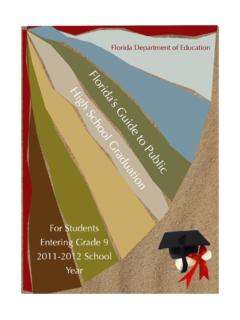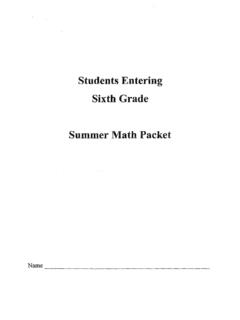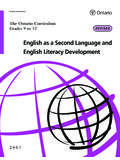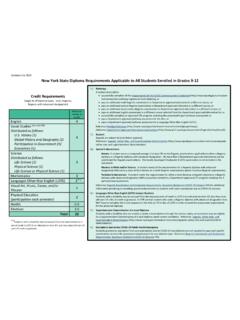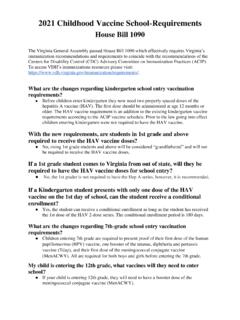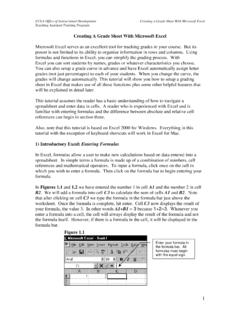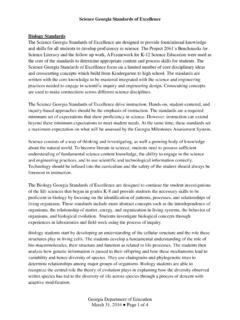Transcription of Behavioral Strategies for Students with Autism in the ...
1 JAASEP: FALL 2009 114 Behavioral Strategies for Students with Autism in the General Education Classroom Hope Bice St. Clair County Preschool Springville, AL Abstract The following article examines how Behavioral interventions used in the general education classroom effect Students with Autism . The number of Students with Autism has increased significantly in the past 10 years. Teachers are now faced with providing instruction in inclusive settings within the general education classroom environment. Teachers need to have relevant and important Strategies to decrease inappropriate, as well as, increase appropriate behaviors for Students with Autism to be successful in the general education classroom. The following project was conducted in the spring of 2009 at Springville Elementary School in Springville, Alabama. It focused on three classrooms which included a total of four Students with a diagnosis of Autism . The objective of the project was to focus on Behavioral interventions that can be used in the general education environment to decrease inappropriate behaviors, increase appropriate behaviors and increase Students time in the classroom with their typical peers.
2 Behavioral Strategies for Students with Autism in the General Education Classroom According to the Centers of Disease Control (2007), the prevalence of Autism has increased to 1 in 150 in the past year. Each year more Students with Autism enter public school systems and generally have least restrictive environments (LRE) written into their Individualized Education Programs (IEPs) for placement in the general education classroom. Unfortunately, most general education teachers have little to no training in working with Students with Autism . The trend of inclusion of Students with disabilities including Autism has been mostly lead by theoretical arguments related to social development and legal issues. Researchers have documented that Students with disabilities that are included in the general education classroom display larger friendship bases, give and receive higher levels of social support, exhibit higher levels of social interaction, and have more advanced IEP goals than Students in segregated placements (Harrower & Dunlap, 2001).
3 Common Behaviors in Children with Autism Students with Autism exhibit various types of behavior in and out of the classroom. Many of which could be a major distraction within the general education classroom JAASEP: FALL 2009 115environment. Some common behaviors are clapping, hand flapping, self injurious behaviors, and yelling. Others might include rocking, mouthing objects, intense staring, and fixation on certain objects and/or subjects. Not all Students exhibit the same behaviors. Each student s needs will be different as far as his or her behavior is concerned (Harrower & Dunlap, 2001). Why Behaviors Occur There are many reasons unwanted and/or inappropriate behaviors occur. Generally, no two Students patterns of behavior are the same. The student may be bored, frustrated, or have a lack of motivation for learning. The student just may not understand that certain behaviors are not permissible. The student may be having problems at home and is lashing out for attention at school.
4 There is a possibility that the list of reasons could be endless, however it is important to analyze the behaviors that are consistently exhibited by the student so that appropriate interventions can be implemented (Cohen & Spenciner, 2005). Most Students with Autism have difficulty with social interactions and are believed to be uninterested in interacting with others. Many Students with Autism have mild to severe sensory issues which make their participation in busy, sometimes loud, classrooms with many Students hard to deal with . They may be overly stimulated to the point that they exhibit self-stimulatory behaviors to calm themselves which may possibly be a distraction to their classmates and teacher(s) (Schaaf & Miller, 2005). Analyzing Behaviors The most common way to analyze behaviors is to complete a Functional Behavior Assessment. Functional Behavior Assessments are used by educators to examine student behavior and to assist in identifying its function.
5 The information gathered is then used to plan intervention and positive Behavioral supports that are written into Students Behavioral intervention plans. To identify the problem behavior, the behavior must be concrete and observable. Standardized assessments, record reviews, structured interviews, and observations are all used to successfully complete Functional Behavior Assessments (Cohen & Spenciner, 2005). Ways to Reduce Undesired Behaviors There is no single, effective intervention to reduce or eliminate undesirable behaviors in children with Autism . However, there are many proactive Strategies that can be used; it just depends on the child. Each situation must be looked at individually and all persons involved must work together and be as consistent as possible to benefit the child to the maximum extent possible. Antecedent Procedures Antecedent procedures are a proactive approach to prevent and reduce challenging behaviors by addressing the behavior before its occurrence.
6 The most common JAASEP: FALL 2009 116antecedent procedures are priming, prompt delivery, and picture schedules. Priming allows the child with Autism to have an introduction to the lesson before the larger classroom lesson. It focuses on increasing social interactions throughout the school day. Prompt delivery pairs teacher with a typically developing student and a student with Autism . The teacher prompts and models for the typically developing student and then has that student to prompt the student with Autism (Harrower & Dunlap, 2001). Delayed Contingencies Oftentimes Students with Autism depend on positive reinforcement throughout the activity they are working on or the school day in general. In most situations, an adult cannot be with them one hundred percent of the time. On the other hand, a long term goal of independence is also an unspoken expectation for all Students so educators and administrators must look at removing contingencies to foster independence.
7 The removal of contingencies must take place gradually by thinning reinforcement schedules and delaying delivery of corrective feedback (Griffin, Griffin, Fitch, Albera, & Gringas, 2006). Self-Management Strategies Students must learn self-management skills. The push toward Students being actively engaged in their educational programs is a very popular concept in public schools today. Students need to be able to use self-control to monitor their own behaviors as well as evaluate their school work. Ways to evaluate include: Self-correction, self-recording, self-monitoring, self-reporting, and self-graphing. Students can monitor their own work, record their own behavior, report findings to teacher, and graph their own evaluations of behaviors. Students may use their finding to reinforce themselves with schedules and rewards (Rivera & Smith, 1997). Prompts that encourage the use of self-management skills in the classroom include verbal cues, hand motions, physical prompts, timers, and a watch with an alarm (Wilkinson, 2008).
8 Social Stories Social stories are short stories that describe relevant aspects of specific social situations. The aim of social stories is to teach social-perspective-taking to help interpret social cues and allows Students to read social situations. They can be pictures and/or words, long or short, typed or handwritten. Social stories should be individualized to each situation and consist of descriptive, directive, perspective, and affirmative sentences (Delano & Snell, 2006). Areas where social stories may be extremely beneficial to the general education classroom teacher may include fire drill, tornado drill, assembly, change in scheduling, and preparation for a substitute (Gray, 2000). Picture Schedules Picture schedules use pictures of activities and/or objects for increasing predictability and as an alternative to verbal and written instruction. It allows the teacher to set up the JAASEP: FALL 2009 117child s day and for them to manipulate what they must do, have done, and must finish within a certain time frame.
9 Pictures may be of actual objects or from one of the many widely used picture symbol programs that are now available. Instead of pictures actual objects may be used, for example, a spoon may be used for breakfast; a ball may be used for physical education or recess time (Harrower & Dunlap, 2001). Picture Exchange Communication Systems (PECS) PECS was designed to help young children with Autism initiate requests and communicate their needs. The system uses a behaviorally based program to teach the child to exchange a picture card for something he/she likes and wants. It starts with single pictures and then the pictures are combined with statements for requests. The pictures may be kept in a binder and used as needed. A teacher may add pictures at any time he/she feels the student needs them. Pictures may be used for classroom assignments and allowing the student to participate in classroom activities (Harrower & Dunlap, 2001). For this project, Behavioral interventions were designed to decrease inappropriate behaviors of Students with Autism .
10 Strategies were introduced to be used in the general education classroom during instructional and non-instructional time. The goal was for the Strategies to increase participation and time spent in the general education classroom while decreasing inappropriate behaviors. Method Participants The focus of this project was directed at one second grade general education classroom, one third grade general education classroom, and one fourth grade general education classroom. The second grade class has two Students with Autism , third grade has one, and fourth grade has one. Each student has had the diagnosis of Autism since before entering kindergarten. All of the Students attend Springville Elementary School and receive varying types of special education services. General education teachers and paraprofessionals assigned to the Students were trained in Behavioral Strategies . Each person participating had very little training in working with Students with Autism prior to this project.










